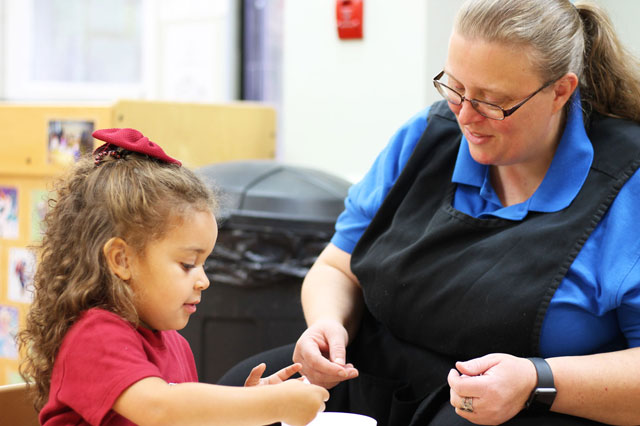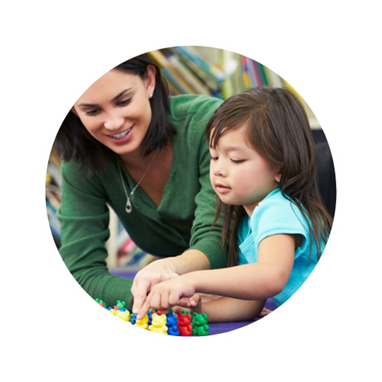Smooth Transitions as a Key to Success
by Jaime Rechkemmer, Vice President of Education
We know that transitioning between activities and locations can be challenging for toddlers and preschool-aged children. Think about how many times each day our kiddos start an activity, stop an activity, clean up, wash hands, eat, go outside, come inside, go to sleep, wake up, and more!
Being asked to stop one activity and start another is a common trigger for challenging behavior in all children, especially when they are being asked to transition from something they love to something less exciting – think about how you feel at the end of the best concert of your life, or when your favorite friend has to go home. The good news is that we can help children be more successful during transitions with some simple planned experiences and a lot of patience and love.
Transition Activity Ideas for Toddlers and Preschoolers
The options for transition activity ideas are endless. Be creative! Here are a few suggestions to get you started:
1. Use a fun song get children ready to line up.
“I am Ready” (Tune – “Frère Jacques”)
I am ready (children echo)
My eyes look front (children echo)
My hands are by my sides, (children echo)
My mouth is smiling! (children echo) (or “my mouth says ‘shhh’”)
2. Make the transition into a game.
When children are having fun during the transition, even those who typically struggle might have better cooperation.
- During clean up time or another challenging transition, bring in a little excitement by asking children to do the task in a new way. Maybe they can pretend they are elephants and pick up toys with their “trunk!”
- When moving from one area to another, incorporate movement! Hop on one foot, walk like a crab, or tip toe.
- Sometimes adding a time challenge is just the motivation children need to initiate the transition. Set a timer and challenge them to clean up or line up before the timer goes off, or play a song and let the end of the song be the target for finishing the transition task.
3. Use a fun finger play during waiting time.
Use finger plays to engage children anytime you find them having to wait for an activity to start. Here are two from Learning Without Tears that are easy to memorize and fun! (They teach important fine motor and school readiness skills too!)
| Five Finger Counts | Ten Little Fingers |
| 1 finger points. | Ten little fingers and they all belong to me. |
| 2 fingers walk. | I can make them do things, just you wait and see. |
| 3 fingers stand up and talk, talk, talk. | I can wave them high and I can wiggle them low. |
| 4 fingers count: 1 – 2 – 3 – 4 | I can push them on the floor and stretch them just so. |
| Oh, look! I’ve got one more. | |
| 5 fingers UP! |
Would you like more information on transition activities? Keep reading…
First, let’s define a transition activity.
Transition activities are strategies and calming techniques used during times of change to promote self-regulation and reduce the likelihood of challenging behaviors. Remember that little learners are not yet ready to fully cope with frustration and disappointment. They are still learning to control their emotions and manage their behavior. With our help, though, kiddos can learn to manage transitions successfully.
Why are transition activities important?
Transition activities and strategies promote self-regulation by helping kiddos know what to expect and by guiding them to make more positive choices during change. We can empower children to maintain self-control even when transitioning away from a favorite activity.
Here are a few good opportunities to implement a transition strategy:
- Separating from family upon arrival to school
- Moving from one activity, interest area, or location to another
- Clean-up time
- Lining up or washing hands or toileting
- Coming inside from the playground
- Times of waiting for an activity to start or waiting for a turn
One major key to success when helping children with transitions is looking first at YOUR behavior. As the classroom leader, it is up to you to develop consistent schedules and routines for the kiddos. As you imagine ways that you can help with transitions, keep the following tips in mind. Again, notice that these activities are mostly things for YOU to do:
- Provide visuals. Include pictures or symbols in your schedule. Being able to point to what is coming next is powerful.
- Give a preview. Review the schedule with little learners each morning. Use your pictures and symbols to give cues as well.
- Establish routines. Within each part of the schedule, establish a routine. Routines are comforting for children and promote independence. A daily arrival routine might include putting belongings in a cubby, washing hands, and then completing an attendance task like putting a magnet on their name.
- Create rituals. Rituals help establish a connection between you and the kiddos, the classroom, and your center. For example, use certain songs for specific transitions (e.g., hello song, clean up song, hand washing song). Rituals should be positive and strengths-based, activities that kiddos want to be part of. For instance, “Catch a Bubble” to encourage listening skills is not a developmentally-appropriate ritual. Who really wants to hold air in their cheeks ‘til it hurts?
- Make a plan. Pre-determine what children and adults will be doing during transition times and allow time in the schedule for the transition activity. Will they sing a song, listen to a story, listen to background music, or carry an item? And limit transitions. When possible, limit or combine transitions (e.g., plan the bathroom break on the way to the playground).
- Give advanced warning. Give a verbal or nonverbal warning to prepare children for an upcoming transition. A verbal warning might be “Five more minutes until we clean up for a snack!” A nonverbal warning could be turning the lights off as the five-minute warning. Because young children do not have a well-developed sense of time, a visual timer is a great way for children to visualize how much time is remaining.
Look for Part 2: More Tips for Smooth, Successful Transitions next month.


